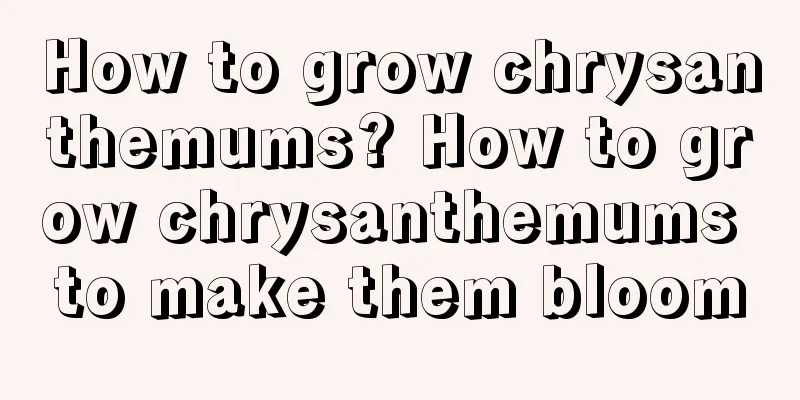Planting technology and cultivation management methods of Belamcanda chinensis

|
Belamcanda chinensis , also known as Cun Gan, Wu Shan or Golden Butterfly, is a plant belonging to the Iridaceae family, and its rhizome is used as a medicinal material. This plant prefers a warm environment. When the temperature is between 20℃ and 25℃ and the soil moisture reaches 50%, the seeds begin to germinate. When the ambient temperature is between 25℃ and 35℃, the light duration is long, the soil temperature is high, and there is abundant rainfall, the growth of Belamcanda oleifera will appear particularly vigorous. In addition, Belamcanda chinensis is drought-resistant and cold-resistant, and can safely survive the winter even in areas where the temperature drops to -17℃. Let's learn about the planting technology and cultivation management methods of Belamcanda chinensis. 1. Land selection Choose sandy loam land or gently sloping land with higher terrain, plenty of sunlight, deep soil and good drainage. If barren hills or sloping land are used, the land should be plowed in the autumn or winter of the previous year to allow the soil enough time to weather and mature. Plow the land again in spring to remove debris. If arable land is used, it needs to be plowed and 100 kg of superphosphate or 50 kg of compound fertilizer applied before planting. 2. Sowing time Direct seeding can be adopted, with spring sowing in early March to mid-April and autumn sowing in September to October. On the leveled bed surface, sow seeds at a row spacing of 30 cm and a sowing depth of 1.5 to 2 cm. After sowing, keep the soil moist to promote seed germination and seedling growth. 3. Seedling management After the seedlings emerge from the soil, inter-row cultivation and weeding should be carried out in time, and thinning should be carried out when the seedlings are 6 to 10 cm tall. If bolting occurs, it should be pruned back to promote root development. The seed rate required for direct seeding is 5 to 6 kilograms per mu, and the same is true for seedling cultivation. Seedlings will emerge in the spring of the second year after autumn sowing, and about 30 days after spring sowing. After one year of growth, it can be transplanted in autumn or spring. One acre of nursery land can transplant 6 to 7 acres. 4. Intertillage and weeding After the seedlings of Belamcanda chinensis emerge or survive after transplanting, regular tillage and weeding are required, 3 to 4 times a year. In the first year of spring sowing, it is carried out once in May, July and November, and in the second year it is carried out in March, June and November. 5. Fertilization management Belamcanda chinensis likes fertilizer. In addition to applying sufficient base fertilizer, top dressing is required once in the spring, summer and autumn of the second year. In spring and summer, apply 25 to 30 kg of urea per mu, and in autumn, apply 25 kg of compound fertilizer. The first two top dressings help the growth of stems and leaves, while the last one promotes the growth of roots and stems and increases yield. 6. Water management Belamcanda chinensis is not tolerant to waterlogging and needs to be drained in time after heavy rain to prevent root rot. Although it is drought-tolerant, the soil needs to be kept moist during the seedling stage and after transplanting. After the seedlings are 10 cm tall, irrigation can be reduced or stopped. 7. Picking buds If rhizomes are used for planting, it will bloom in the same year; if seeds are used for seedlings or direct seeding, the flowers will be less in the first year, but more in the next year. The flowering period is long, and flowering and fruiting will consume a lot of nutrients, affecting the growth of rhizomes. In addition to leaving the land for seeds, when the plants are bolting, you should choose a sunny morning when the dew has dried up to remove the flower buds, and remove them cleanly in stages and batches. If you want to collect seeds, you don't need to pick the buds. 8. Harvesting and processing Belamcanda chinensis is usually harvested after growing for 2 to 3 years or longer, and most are harvested after two years. When harvested in autumn, the rhizome depth is about 6 to 8 cm. Dig out the rhizomes in late autumn, remove the fibrous roots and dry them in the sun to become medicinal materials. The general yield per acre is 250 to 300 kilograms of dry goods. The above is an introduction to the key points of planting, cultivation and management techniques of Belamcanda chinensis. As a Chinese medicinal plant with good efficacy, Belamcanda chinensis has a good planting prospect, but people should not blindly follow the trend in planting it.
|
<<: What is the best fertilizer for orchids?
>>: How to grow asparagus fern
Recommend
Can Kalanchoe be pruned in summer? Where is the best place to prune?
The purpose of pruning Kalanchoe is to make its a...
What should we pay attention to in strawberry planting and management techniques?
Strawberry is a very widely grown fruit and is kn...
When do lotus leaves wither?
1. When will it wither? Its leaves naturally with...
What soil is best for growing orchids (detailed explanation of preparation method)
1. Flower soil requirements 1. Loose: The soil fo...
Take advantage of this season and plant flowers all over the walls of your home!
ivy (Author: bossanbaby Source: Ivy Bar) Tips for...
How to grow hyacinth in autumn
1. Maintenance methods 1. Light: It has a demand ...
How to water bamboo orchid
1. Watering principles Water when it is dry, stop...
Pumpkin's growing environment and local conditions
Pumpkin growing environment and conditions Pumpki...
What is the flower of the king?
What is the flower of the king? The queen flower ...
How to grow Dracaena fragrans well
1. Soil suitability If you want the Dracaena to g...
The efficacy and function of Melaleuca alternifolia
effect: Medicinal effects: It has a good therapeu...
How to grow and propagate green claw succulents
1. How to raise 1. Plenty of sunlight: Green claw...
What flowers are suitable for growing in Ganzi? What are the city flowers and trees?
1. Climate characteristics of Ganzi Ganzi has a p...
Types of pumpkins, pictures of pumpkins
1. Types of Pumpkin Honey Pumpkin: It is a hybrid...
How to make bonsai from wine bottles
Selecting plants The first thing we need to do is...









